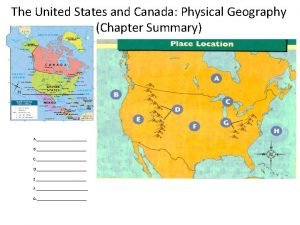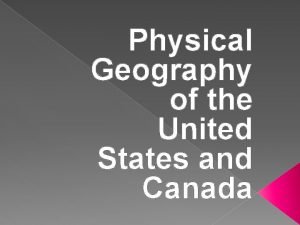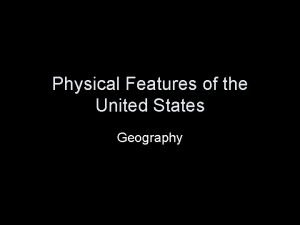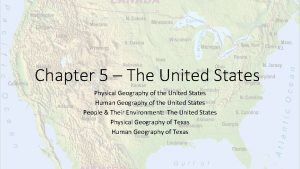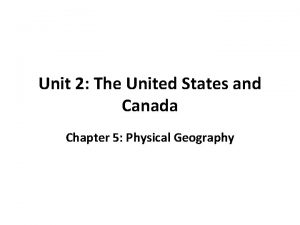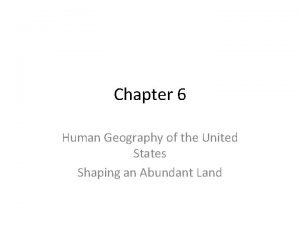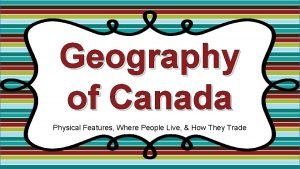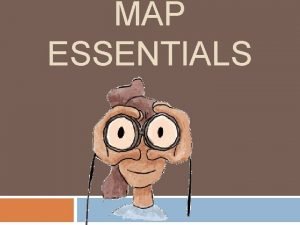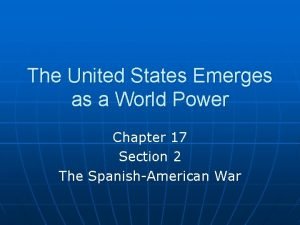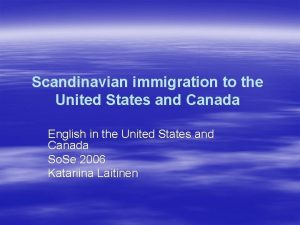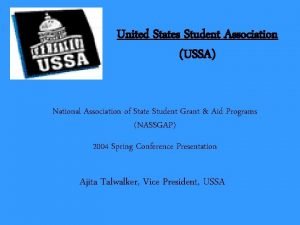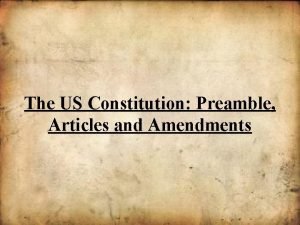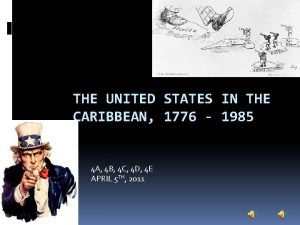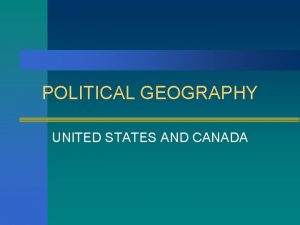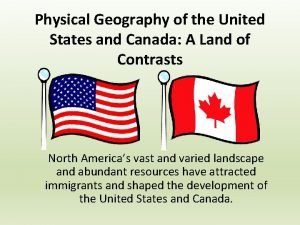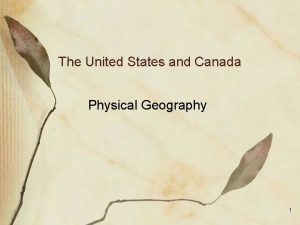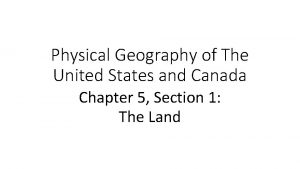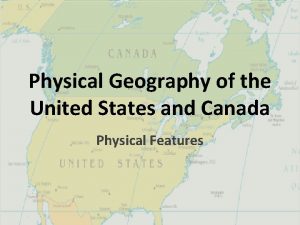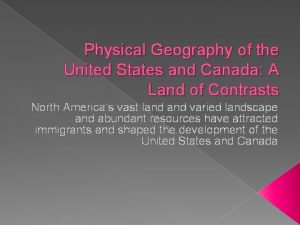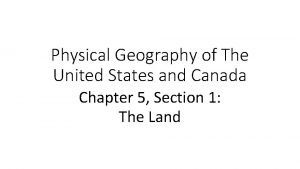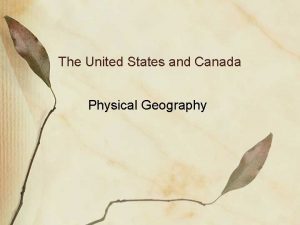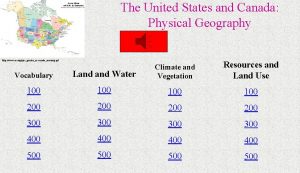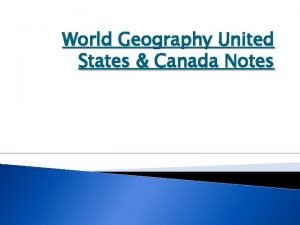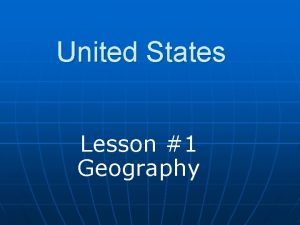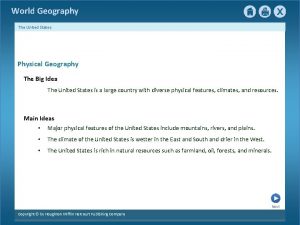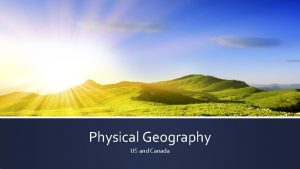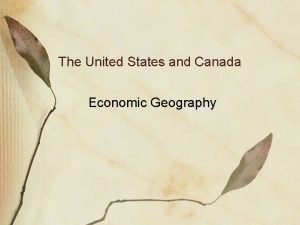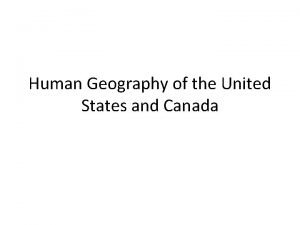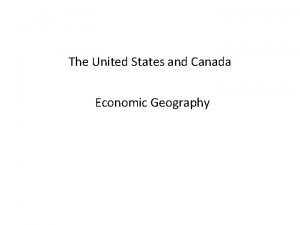Physical Geography of The United States and Canada





















- Slides: 21

Physical Geography of The United States and Canada Chapter 5, Section 1: The Land

North America

Important Vocabulary • Divide: is a high point or ridge that determines the direction in which rivers flow. Ex: the Rocky Mountains. • Headwaters: a source of water for rivers. Ex: the Rockies to the Colorado River and Rio Grande. • Tributary: small rivers or streams connecting with a large river. • Fall Line: in the eastern United States, marks the place where the higher Piedmont drops to the lower Atlantic Coastal Plain.

Vocabulary (Cont’d) • Fossil Fuel: natural resources such as coal and petroleum (oil). They are not renewable. • Fishery: coastal waters (Atlantic and Pacific) along with the Gulf of Mexico that are rich with fish and shellfish. • Aquaculture: a growing economic activity of fish farming.

Landforms • The Pacific Ranges include: Sierra Nevada, the Cascade Range, the Coast Range, and the Alaska Range. • The Rocky Mountains link the United States and Canada.

Alaska Range & The Rockies

Landforms (Cont’d) • Dry basins and plateaus between the Pacific Ranges and the Rockies. The Grand Canyon is the steepest. • Flat land mass – the Great Plains to the Mississippi River. • The Appalachian Mountains – Quebec to Alabama. • The Canadian Shield is on the Hudson and James Bays.

Grand Canyon & Great Plains

Appalachian & Canadian Shield

Water Systems • Niagara Falls – border between the United States and Canada. • Another water boundary are the Great Lakes.

Niagara Falls & Great Lakes

Mississippi River

Fossil Fuels and Minerals • Natural resources: oil, timber, coal, and natural gas. • The Rockies have: gold, silver, and copper. • Other mineral resources: iron ore and nickel.

Physical Geography of The United States and Canada Chapter 5, Section 2: Climate and Vegetation

Important Vocabulary • Hurricane: Ocean storms hundreds of miles wide with wind speeds over 74 mph. • Chaparral: a drought-resistant woodland of twisted, hardleafed trees. • Prairie: naturally treeless expanses of grasses spread along the Great Plains. • Supercell: violent spring and summer thunderstorms in the Great Plains and eastern United States.

Vocabulary (Cont’d) • Timberline: the elevation above which trees cannot grow, lichens and mosses grow. • Chinook: a warm, dry wind (in the early spring) that blows down the eastern slopes of the Rockies, melting snow. • Blizzard: during the winter winds, over 35 mph, blowing or heavy snow.

Southern Climates • Humid, subtropical climate. • Wetlands and swamps (The Everglades) provide vegetation and wildlife. • Rain shadow effect creates desert areas (Death Valley). • Hot, dry summers and mild, wet winters.

Northern & Coastal Climates • Northern climates experience changing seasons. • The interior has very cold winters and hot summers. • The upper west coast has an overcast, rainy winter. Summers are cloudless and cool.

1930 s Dust Bowl

High-Latitude Climates • Canada and Alaska have very cold winters. • The northern parts are vast wilderness and inhospitable. • Mixed forests from Newfoundland into the subarctic Yukon Territory (Canada).

Newfoundland & Yukon Territory
 Does canada have mountains
Does canada have mountains United states and canada physical map
United states and canada physical map Physical feature map of the united states
Physical feature map of the united states Physical geography of the united states
Physical geography of the united states What states are west of the mississippi river
What states are west of the mississippi river Settlement patterns
Settlement patterns Unit 2 the united states and canada worksheet answers
Unit 2 the united states and canada worksheet answers Why is the united states called a postindustrial economy
Why is the united states called a postindustrial economy Canada physical regions
Canada physical regions Awake united states!
Awake united states! United states map with longitude and latitude lines
United states map with longitude and latitude lines Us history regents essay
Us history regents essay The united states emerges as a world power
The united states emerges as a world power How many states canada
How many states canada Was the united states on the axis powers or allied powers?
Was the united states on the axis powers or allied powers? Sectionalism map of the united states
Sectionalism map of the united states Usa pro soccer teams
Usa pro soccer teams United states v nixon outcome
United states v nixon outcome United states student association
United states student association The united states ought to provide a universal basic income
The united states ought to provide a universal basic income What is preamble
What is preamble The united states in the caribbean 1776-1985
The united states in the caribbean 1776-1985
